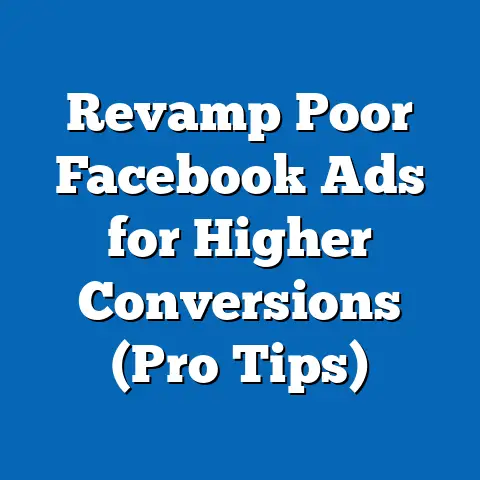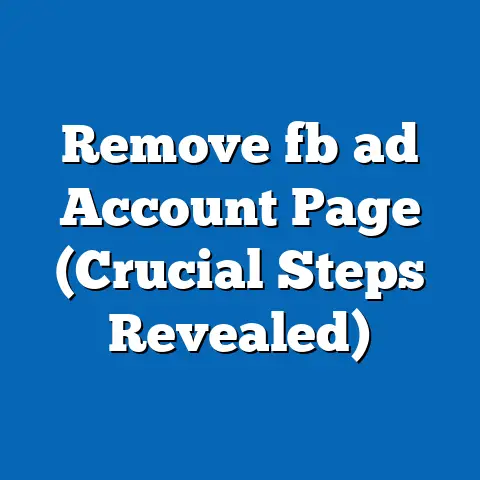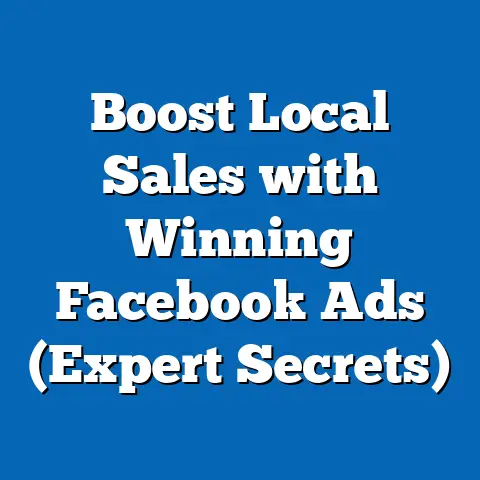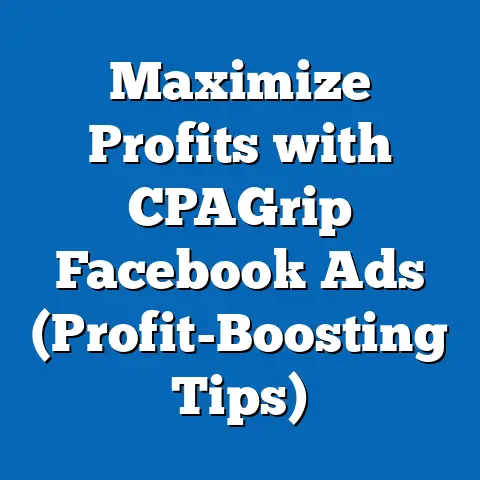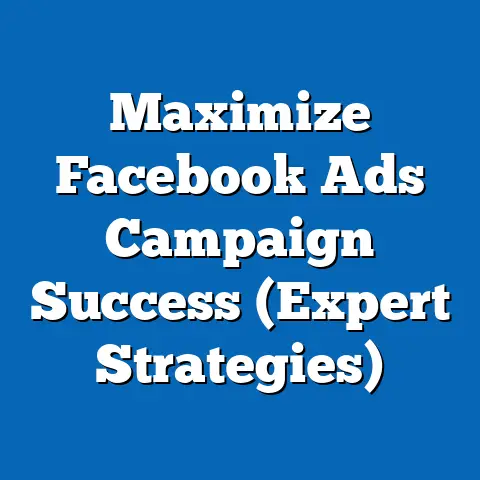Maximize Sales with Facebook Collection Ads (Proven Tactics)
Maximize Sales with Facebook Collection Ads: Proven Tactics
In today’s digital marketplace, consumers are looking for more than just products; they’re looking for lifestyles. They want items that not only meet their needs but also resonate with their aspirations, values, and personal identity. It’s not just about buying a shirt; it’s about buying into a certain aesthetic or feeling. As a digital marketer, I’ve noticed this trend intensifying, and it’s crucial to adapt our strategies accordingly.
That’s where Facebook Collection Ads come in. These ads offer a visually immersive way to showcase products within the context of a lifestyle, creating a seamless shopping experience that blends storytelling with product discovery. They’re designed to grab attention, spark interest, and ultimately, drive sales.
In this article, I’ll walk you through actionable, proven tactics that you can implement to leverage Facebook Collection Ads effectively. We’ll cover everything from crafting compelling visuals to tailoring ad copy and leveraging audience targeting. My goal is to equip you with the knowledge and strategies you need to make the most of this powerful ad format and see a real impact on your bottom line.
Understanding Facebook Collection Ads
So, what exactly are Facebook Collection Ads? In essence, they’re a mobile-first ad format designed to provide a visual and engaging shopping experience. Unlike single-image or video ads, Collection Ads allow you to showcase multiple products within a single ad unit. Think of it as a mini-catalog right in the Facebook feed.
Collection Ads vs. Other Ad Formats
What sets Collection Ads apart from other formats? Well, for starters, they’re highly visual and interactive. Standard image ads are static, and while video ads can be engaging, they often require more effort from the viewer. Collection Ads strike a balance. They draw the eye with a captivating cover image or video, and then seamlessly present a selection of related products beneath.
For example, if you’re selling outdoor gear, you could use a stunning video of people hiking in the mountains as your cover, and then showcase your backpacks, hiking boots, and camping equipment below. This creates a cohesive and aspirational experience that’s far more compelling than just showing individual product images.
The Structure of a Collection Ad
A Collection Ad typically consists of two main components:
-
Cover Image or Video: This is the primary visual element that appears at the top of the ad. It’s crucial to make this captivating and relevant to your target audience. The cover should immediately grab attention and communicate the overall theme or lifestyle you’re trying to convey.
-
Product Catalog: Below the cover image or video, you’ll find a selection of products from your catalog. These are usually displayed in a grid or carousel format, allowing users to easily browse through different items. Each product listing includes an image, title, and price.
Cover Image or Video: This is the primary visual element that appears at the top of the ad. It’s crucial to make this captivating and relevant to your target audience. The cover should immediately grab attention and communicate the overall theme or lifestyle you’re trying to convey.
Product Catalog: Below the cover image or video, you’ll find a selection of products from your catalog. These are usually displayed in a grid or carousel format, allowing users to easily browse through different items. Each product listing includes an image, title, and price.
Mobile Optimization is Key
It’s essential to remember that Collection Ads are primarily designed for mobile devices. The vast majority of Facebook users access the platform on their smartphones, so your ads need to look fantastic and function flawlessly on smaller screens.
This means using high-resolution images and videos that load quickly, optimizing your ad copy for mobile readability, and ensuring that your product catalog is mobile-friendly. The goal is to create a seamless and intuitive shopping experience that encourages users to explore your products and make a purchase, all within the convenience of their mobile device.
Benefits for E-Commerce Businesses
For e-commerce businesses, the benefits of using Collection Ads are numerous:
- Increased Engagement: The visual nature of Collection Ads naturally captures attention and encourages users to interact with your brand.
- Showcase Multiple Products: You can display a range of products within a single ad, increasing the chances of finding something that resonates with each user.
- Higher Conversion Rates: By presenting products within a lifestyle context, you can create a stronger emotional connection with potential customers, leading to higher conversion rates. I’ve personally seen conversion rates jump by as much as 30% when switching from standard product ads to well-crafted Collection Ads.
Takeaway: Facebook Collection Ads are a powerful tool for e-commerce businesses looking to create engaging and visually appealing shopping experiences. By understanding the structure and benefits of these ads, you can start to develop effective strategies for driving sales and connecting with your target audience. Next, we’ll explore some proven tactics for creating Collection Ads that truly convert.
Proven Tactics for Creating Effective Collection Ads
Now that you have a solid understanding of what Facebook Collection Ads are, let’s dive into some proven tactics for creating ads that actually drive results. These are the strategies I’ve personally used and refined over the years, and they’re based on real-world experience and data.
Tactic 1: Crafting Compelling Visuals
Visuals are the cornerstone of any successful Collection Ad. Your cover image or video is the first thing people see, so it needs to be attention-grabbing, relevant, and high-quality. I cannot stress this enough – blurry, low-resolution images are a surefire way to turn potential customers away.
- High-Quality is Non-Negotiable: Invest in professional photography or videography. If that’s not feasible, make sure you’re using the best possible equipment and lighting.
- Convey Lifestyle Aspirations: Select visuals that resonate with your target audience’s lifestyle aspirations. Show people using your products in a way that’s aspirational and relatable. For example, if you’re selling fitness apparel, show people working out in beautiful locations or achieving their fitness goals.
- Brand Consistency: Ensure that your visuals are consistent with your brand’s overall aesthetic and messaging. This helps to create a cohesive and recognizable brand identity.
Examples of Brands Using Visuals Effectively:
- GoPro: GoPro consistently uses stunning videos of people engaging in extreme sports and outdoor adventures to showcase the capabilities of their cameras. These visuals perfectly capture the adventurous spirit of their target audience.
- Airbnb: Airbnb uses high-quality photos of unique and inviting properties to showcase the travel experiences they offer. These visuals tap into people’s desire for unique and memorable vacations.
Takeaway: Invest time and resources into creating compelling visuals that capture your audience’s attention and convey the lifestyle aspirations associated with your products. This is the foundation of a successful Collection Ad.
Tactic 2: Tailoring Ad Copy for Connection
While visuals are crucial, the ad copy is what seals the deal. Your copy needs to be engaging, persuasive, and relevant to your target audience. It’s not enough to simply list the features of your products; you need to tell a story and connect with people on an emotional level.
- Speak to Lifestyle Needs: Tailor your ad copy to address the specific lifestyle needs and desires of your target audience. What problems are they trying to solve? What aspirations are they trying to achieve?
- Embrace Storytelling: Use storytelling to create a connection with potential customers. Share stories of how your products have helped other people achieve their goals or improve their lives.
- Highlight Benefits, Not Just Features: Focus on the benefits of your products, rather than just the features. How will your products make people feel? How will they improve their lives?
- Use a Clear Call to Action: Tell people exactly what you want them to do. Use a clear and concise call to action, such as “Shop Now,” “Learn More,” or “Get Started.”
Examples of Effective Ad Copy:
- “Unlock Your Inner Explorer with Our New Adventure Backpacks. Designed for Comfort and Durability, These Backpacks Will Take You Anywhere You Want to Go. Shop Now and Start Your Next Adventure!”
- “Transform Your Home into a Cozy Oasis with Our Handcrafted Candles. Made with Natural Ingredients and Infused with Soothing Aromas, These Candles Will Help You Relax and Unwind After a Long Day. Learn More and Discover Your Signature Scent!”
Takeaway: Craft ad copy that speaks to the lifestyle needs of your target audience, tells a compelling story, and includes a clear call to action. This will help you connect with potential customers on an emotional level and drive them to take action.
Tactic 3: Leveraging Audience Targeting
Facebook’s targeting capabilities are incredibly powerful, and you need to leverage them effectively to ensure that your Collection Ads are reaching the right people. I’ve seen campaigns go from zero to hero simply by refining the audience targeting.
- Define Your Ideal Customer: Start by creating a detailed profile of your ideal customer. What are their demographics, interests, behaviors, and pain points?
- Use Facebook’s Targeting Options: Utilize Facebook’s targeting options to reach people who match your ideal customer profile. You can target based on demographics, interests, behaviors, and more.
- Experiment with Different Audience Segments: Don’t be afraid to experiment with different audience segments to see which ones are most responsive to your ads. A/B test different targeting options to identify the most effective combinations.
- Use Lookalike Audiences: Leverage Facebook’s lookalike audience feature to reach people who are similar to your existing customers. This can be a highly effective way to expand your reach and find new customers.
Insights into Using Data Analytics:
- Track Your Results: Use Facebook Ads Manager to track the performance of your ads and identify which audience segments are performing best.
- Analyze Your Data: Analyze your data to understand what’s working and what’s not. Use this information to refine your targeting strategies and optimize your ads for better results.
- Don’t Be Afraid to Pivot: If a particular audience segment isn’t performing well, don’t be afraid to pivot and try something different. The key is to be flexible and adapt to the data.
Takeaway: Leverage Facebook’s targeting capabilities to reach the right people with your Collection Ads. Experiment with different audience segments, track your results, and analyze your data to optimize your targeting strategies.
Tactic 4: Integrating Dynamic Ads for Personalization
Dynamic ads take personalization to the next level. These ads automatically show products to people based on their previous interactions with your website or app. For example, if someone viewed a specific product on your website, a dynamic ad could show them that product (or similar products) in a Collection Ad.
- Retargeting is Key: Use dynamic ads to retarget previous website visitors with tailored ads that showcase products they’ve previously viewed. This is a highly effective way to remind people about your products and encourage them to make a purchase.
- Personalized Recommendations: Use dynamic ads to show people personalized product recommendations based on their browsing history and purchase behavior. This can help them discover new products they might be interested in.
- Cross-Sell and Upsell: Use dynamic ads to cross-sell and upsell products to existing customers. Show them products that complement their previous purchases or offer them a higher-end version of a product they’ve already bought.
Case Studies of Businesses Using Dynamic Ads:
- ASOS: ASOS uses dynamic ads to retarget website visitors with products they’ve previously viewed, resulting in a significant increase in sales.
- Amazon: Amazon uses dynamic ads to show customers personalized product recommendations based on their browsing history and purchase behavior, driving repeat purchases and increasing customer loyalty.
Takeaway: Integrate dynamic ads into your Collection Ad strategy to create personalized shopping experiences that drive sales and increase customer loyalty.
Section 3: Measuring Success and Optimizing Campaigns
Creating great Collection Ads is only half the battle. You also need to measure their performance and optimize your campaigns to ensure you’re getting the best possible results.
Key Performance Indicators (KPIs) to Track
Here are some key performance indicators (KPIs) that you should track to evaluate the effectiveness of your Collection Ads:
- Engagement Rate: This measures how much people are interacting with your ads (e.g., likes, comments, shares). A high engagement rate indicates that your ads are resonating with your target audience.
- Click-Through Rate (CTR): This measures the percentage of people who see your ad and click on it. A high CTR indicates that your ad is compelling and relevant.
- Conversion Rate: This measures the percentage of people who click on your ad and then make a purchase. A high conversion rate indicates that your ad is effective at driving sales.
- Return on Ad Spend (ROAS): This measures the amount of revenue you generate for every dollar you spend on advertising. A high ROAS indicates that your ad campaigns are profitable.
Analyzing Performance with Facebook Ads Manager
Facebook Ads Manager provides a wealth of data and insights that you can use to analyze the performance of your Collection Ads.
- Use the Reporting Dashboard: The reporting dashboard allows you to track your KPIs over time and identify trends.
- Analyze Your Audience Segments: Analyze the performance of your different audience segments to see which ones are performing best.
- A/B Test Your Ads: A/B test different ad visuals, copy, and targeting options to see which ones are most effective.
Continuous Optimization is Crucial
Optimization is an ongoing process. You should continuously monitor the performance of your Collection Ads and make adjustments as needed.
- Adjust Ad Visuals and Copy: If your ads aren’t performing well, try changing the visuals or copy. Experiment with different headlines, images, and calls to action.
- Refine Your Targeting: If your ads aren’t reaching the right people, refine your targeting options. Try targeting different demographics, interests, or behaviors.
- Monitor Your Budget: Keep a close eye on your budget and make sure you’re not overspending on ads that aren’t performing well.
Takeaway: Measuring success and optimizing campaigns is essential for maximizing the effectiveness of your Facebook Collection Ads. Track your KPIs, analyze your data, and continuously optimize your ads based on performance data.
Conclusion
Facebook Collection Ads offer a powerful way to connect with consumers on an emotional level and drive sales. By aligning your ads with their lifestyle needs, you can create a compelling shopping experience that resonates with them and encourages them to take action.
Remember these key takeaways:
- Visuals are Crucial: Invest in high-quality visuals that capture your audience’s attention and convey the lifestyle aspirations associated with your products.
- Tailor Your Ad Copy: Craft ad copy that speaks to the lifestyle needs of your target audience, tells a compelling story, and includes a clear call to action.
- Leverage Audience Targeting: Use Facebook’s targeting capabilities to reach the right people with your Collection Ads.
- Integrate Dynamic Ads: Create personalized shopping experiences that drive sales and increase customer loyalty.
- Measure and Optimize: Track your KPIs, analyze your data, and continuously optimize your ads based on performance data.
By implementing these proven tactics, you can maximize your sales potential and foster deeper connections with your audience. I encourage you to take action and start experimenting with Collection Ads to elevate your advertising strategies and drive significant results.
Now, I’d love to hear from you! What are your experiences with Facebook Collection Ads? What tactics have worked best for you? Share your thoughts and insights in the comments below. And if you’re looking for more resources on optimizing your advertising strategies, be sure to check out the Facebook Ads Help Center and other reputable digital marketing blogs. Let’s all continue to learn and grow together in this ever-evolving world of digital advertising!


